There are many reasons for a site’s traffic to drop. An update in Google’s algorithms can cause a sudden drop or even a gradual decline. Technical issues may be to blame. Or, it’s possible that a competitor has improved and is starting to outrank you.
In this article, we’ll share detailed thoughts to help you assess a drop in Google organic traffic and determine if it is possible to reverse these losses. This advice is based on over ten years of experience in helping site owners diagnose and reverse traffic drops where possible.
We’ll cover the following:
- Google has updated their algorithms
- Technical site problems
- Recent site changes
- Seasonal changes or world events
- SERP changes
- Google penalty (manual or algorithmic)
- Competitors have improved
- Adult content
- A problem on Google’s side (rare)
- The site is new
- Loss of links
- Analytics tracking / reporting issue
- How to assess a slow ongoing decline
- Additional tips from the SEO Twitter community
About Marie Haynes

Marie is the founder of MHC, a digital marketing agency that specializes in understanding and improving website quality in Google’s eyes. MHC is known for their work on improving E-A-T and all other aspects of site quality.
Google has updated their algorithms
Google updates their algorithms several times per day. Most of these will not cause a noticeable change to your site’s traffic.
A few times a year Google makes significant changes to their algorithms that they call core updates. These can be quite impactful. Recent examples include:
- The December 2022 helpful content update – Launched December 5. I am suspicious that many sites with traffic losses that start on a date following December 5 have been impacted by Google’s helpful content system.
- The September 12 2022 core update
- The May 2022 core update – Launched May 25, 2022, and completed June 9, 2022
- The November 2021 core update – Launched November 17, 2021, and completed November 30, 2021
- The June 2021 core update – Launched June 2, 2021, and completed June 12, 2021
Occasionally Google will launch other specific algorithm changes that tend to affect many sites.
Product reviews updates:
- September 20, 2022 (but then this also was a day many sites impacted by Google’s core update were affected.)
- March 23, 2022 to April 11, 2022
- December 1, 2021 to December 21, 2021
- April 8, 2021 to April 22, 2021
Spam updates :
- December 14, 2022 – December Link Spam Update. (However, the December Helpful Content Update was rolling out at this time and many sites with losses are likely caused by that rather than the link spam update.)
- October 19-21, 2022 – This update impacted many sites.
- November 8, 2021
- July 26, 2021 (Specific to link spam)
- June 23 & June 28, 2021
Page Experience / Core Web Vitals Updates:
Note: The page experience updates were discussed in great detail by Google but we have not found them to be impactful. For most of the sites that came to us thinking they have been negatively affected by the page experience update, we have found another cause was more likely. A possible unannounced update on February 24, 2022, affected many sites causing them to incorrectly think they’d suffered because of the Desktop rollout of the core web vitals / page experience update.
- June 15, 2021 – Mobile rollout
- February 22, 2022 – Desktop rollout
Here is my full list of all of the known and suspected Google updates since 2011.
FAQ about a drop in traffic due to a Google update
If you see a drop in traffic in Google Analytics or Google Search Console that starts on or shortly after one of the above dates, it is possible that Google has changed their algorithms in ways that are not favourable to your site.
Update: Added February 2023
Something different is happening in search. Many sites are seeing vast declines in traffic on random dates. For example, on February 4 and 18 many sites lost rankings for a large number of keywords. I am still investigating these dates. (I keep people up to date in my newsletter.) I am suspicious that Google is applying the helpful content classifier to more and more sites. You can read my latest thoughts here on the helpful content classifier.
Here is what it looks like if your site has been hit by a significant Google update.


To find this data in Google Analytics, click on Acquisition → All Traffic → Source/Medium and then select google/organic traffic.
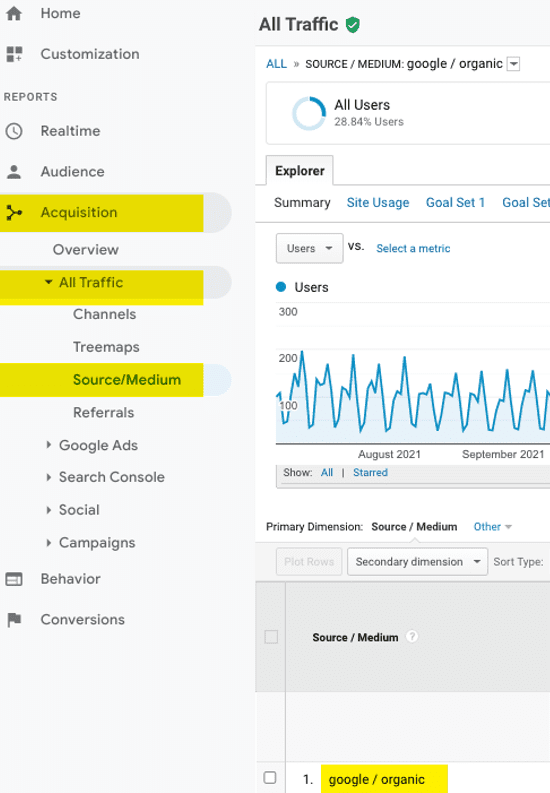
You can also see losses in Google Search Console by looking at clicks or impressions. We don’t tend to spend as much time looking at the average position as these numbers sometimes do not make as much sense.

It is worth noting that we have seen several cases where sites saw drops in traffic coincidental with Google updates where there was another cause. If you have recently made changes to your site such as a migration or significant design change, you should look to these first as a possible reason for your loss in organic traffic. It is also worth reading through the entirety of this article to see if any of the other possible causes for traffic losses could be impacting you.
If you are negatively impacted by a Google update there is no way to know for certain that the update is the cause of your losses. You will not receive a message in Google Search Console. One thing that can be helpful is to determine whether the drop you are seeing also is reflected in traffic from other search engines like Bing or Yahoo!
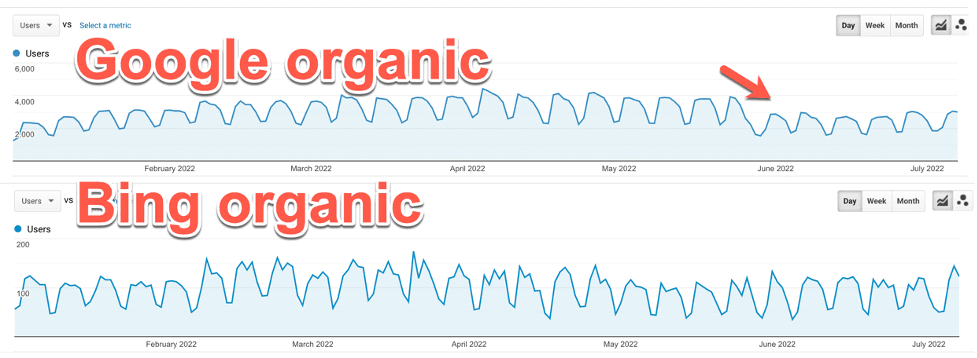
If you see a drop that is only reflected in Google traffic and this coincides with an announced algorithm update, it is likely that the Google update has caused your losses.
Yes. There have been several dates on which we have seen widespread changes in traffic across the hundreds of sites we monitor that we feel were significant but unannounced Google updates. Some of the most significant dates we have noted in our algorithm update list include:
- June 23, 2022
- June 19, 2022
- June 6, 2022
- May 31, 2022
- May 16, 2022
- May 8, 2022
- May 1, 2022
- March 3, 2022
- February 24, 2022
- February 8, 2022
In most cases, the advice for recovery from an unannounced update is the same as our general recovery advice that applies to core update hits as explained in the next section. In the past, we could often pinpoint a specific focus for these updates but in the last few years, most of these changes seem to represent Google getting better at understanding the intent of the searcher and which pages are relevant to that intent.
Some degree of recovery is often possible, but not always.
If you lost organic traffic following a Google core update, this means that Google’s algorithms have found your content less helpful or relevant than other sites. While it is always a good idea to improve the technical health of your website, a core update hit is rarely remedied by making technical fixes.
Core updates are not about breaking Google’s guidelines. They generally tend to be about the quality of the content on your site which often includes elements of E-A-T as well. Google has given guidance to help us assess our content including a list of twenty questions to ask yourself about the quality of your content and the level of E-A-T (Expertise, Authoritativeness and Trustworthiness) users expect to see:
What site owners should know about Google’s core updates
Google says to “focus on content” and to “get to know the quality rater guidelines”, especially the parts that discuss E-A-T. E-A-T can be a component of relevancy. If Google’s algorithms can determine that a searcher is looking to find expert-level advice from an authoritative, trustworthy source, then having external evidence of E-A-T will be important.
In part two of this series on assessing traffic drops, we will go into much greater detail to help you determine if a core update hit is the result of a change in Google’s understanding of relevancy or intent or is due to a general site quality/E-A-T issue.
You may also find our post on the May 2022 core update helpful as it contains our advice for recovery for sites negatively impacted.
If you are able to improve your content quality and E-A-T, you may see some incremental improvements in the months that follow, but in most cases where we have seen good recoveries, we have needed to wait until the next Google core update. In some cases, it can take two core updates in order to see your quality improvements rewarded. Again, core updates happen a few times per year. They are announced by Google on either the Google Search Liaison or Google Search Central Twitter accounts. We also cover any news we can find about Google updates in our weekly SEO newsletter.
Google has given specific advice to help site owners write high-quality product reviews. They want to see that your content reflects that you have expert knowledge of the product you are reviewing, explains the things that are important to users searching for information on this product and much more. It is often not enough to just say you have expert knowledge. When the quality rater guidelines discuss E-A-T they mention repeatedly the importance of not just having expertise but being known as having good expertise.
You can also find information about writing good product reviews that may generate SERP annotations like pros and cons information in this article about newly seen pros and cons SERP features.
At MHC, we have not seen many sites that we confidently felt were hit by any of the recent spam updates. If you run a legitimate site that is not obviously using overtly spammy methods to rank, then you should not be affected by these updates.
If you were affected by the July 2021 link spam update, it is worthwhile reading Google’s documentation on this update. It specifically calls out affiliate links that are followed and do not use rel=”sponsored”, sponsored links (i.e. paid links) and guest post links.
If you have used this type of link to try and improve rankings it is possible that you can see some improvements by making a thorough list of the links and putting them in a disavow file to ask Google not to pay attention to the signals passed through them. However, our experience at MHC is that if Google has discounted links pointing to your site, disavowing them will not cause them to start working to improve rankings like they once did. We still do file disavows for sites that have a manual action for unnatural links or have a link profile that shows very obvious link building for the purpose of PageRank manipulation.
We do occasionally see sites where we feel that a slow erosion in traffic has happened because Google’s algorithms have picked up on years of unnatural link building and subsequently lost trust in the site’s link profile overall. In the past, these sites would see declines that started coincidentally with a Penguin update. But now that Penguin runs in real-time, it can be difficult to determine if link quality is causing issues. There is more on whether link building for SEO can cause traffic losses in the section on manual and algorithmic penalties.
We have written extensively about whether there is value in filing a disavow these days. You can find more information here:
If you are uncertain whether the quality of your links is hindering your site’s ability to rank, there is more information here about MHC’s link overview service where we can help you make disavow decisions.
If you have been negatively impacted by a Google core update, disavowing links will not help. Core updates are about content quality and are not related to breaking Google’s webmaster guidelines. Google’s guidelines on what site owners should know about core updates say,
“There’s nothing wrong with pages that may perform less well in a core update. They haven’t violated our webmaster guidelines nor been subjected to a manual or algorithmic action, as can happen to pages that do violate those guidelines. In fact, there’s nothing in a core update that targets specific pages or sites. Instead, the changes are about improving how our systems assess content overall. These changes may cause some pages that were previously under-rewarded to do better.”
- What site owners should know about Google core updates, from Google.
- 100 Things to know about Google Core Updates, from MHC
- The May 2022 core Google update (includes our advice for recovery), from MHC
Technical problems
There are many technical site issues that can impact ranking. Look for issues that make it difficult for Google to find or crawl your content.
These may include:
- Noindexed pages
- Pages blocked by robots.txt
- Issues with JavaScript that interfere with rendering
- Issues with canonicalization or improper hreflang implementation for international sites
Other technical issues that could cause ranking issues include:
- Hosting issues including overly slow response times
- Orphaned pages (pages that have no links pointing to them)
- Issues where content is different on mobile vs desktop
If you have specific pages that you are having difficulty getting indexed or ranked, it can be helpful to inspect these pages in Google Search Console.
![]()
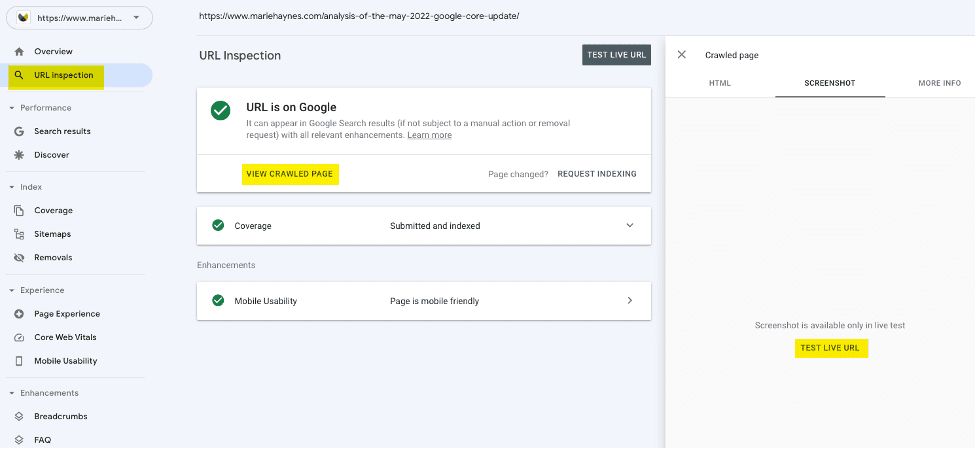
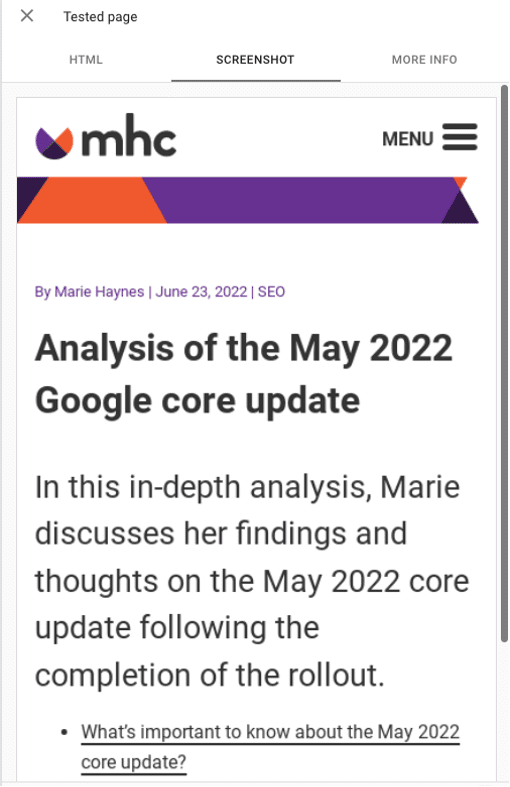
Daniel Waisburg from Google has a great video to explain this even further.
It is harder to debug crawling and rendering issues for a page you don’t have GSC access to, but you sometimes find clues by running a page through Google’s PageSpeed Insight tool. If you see something other than the content that should be visible to searchers such as a popup, odd images, or even a blank page, it might mean Google is not properly seeing your content.
It is a good idea to do a technical audit on any site that is not performing well in search. Tools like Semrush or Ahrefs that run a cursory technical audit can help you find potential technical problems. However, many times these tools will turn up issues that can take a lot of time to fix but are not likely to have caused your drop.
Ultimately using a tool like Screaming Frog to thoroughly crawl a site can give you more information, but you need to have the expertise to know what to do with that info! Again, you are looking to find issues that would prevent Google from crawling, rendering or understanding your content. An alternative is Sitebulb which will give you clues as to what technical problems are present and how or even if they should be remedied.
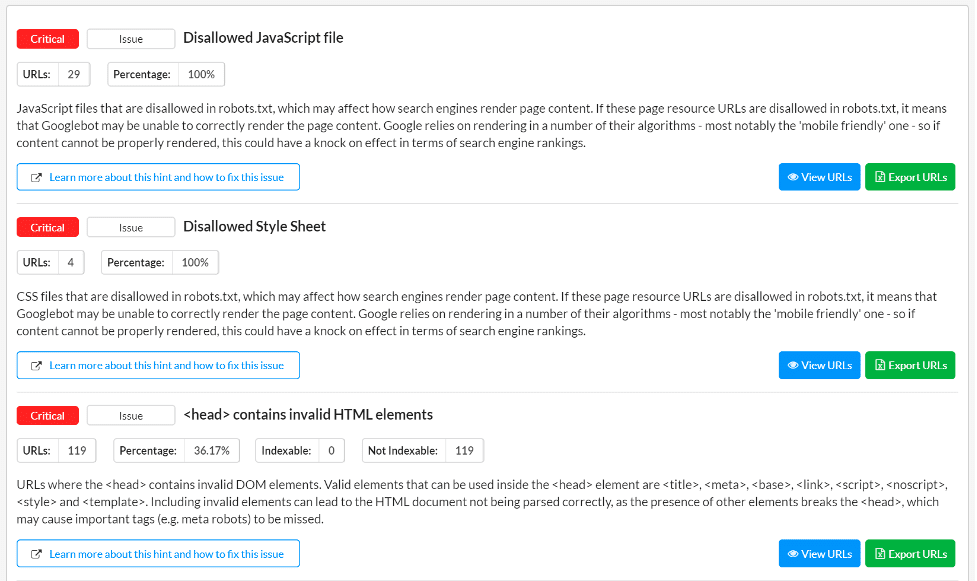
Screenshot of Sitebulb’s audit suggestions
At MHC, we do a lot of traffic drop assessments to help sites determine why their traffic dropped and whether or even how those losses can be remedied. In recent years we have found that technical issues are rarely the cause of a significant drop in traffic that happens in conjunction with a core update. We do occasionally still see traffic drops that happen following poorly thought-out site migrations or other site changes. A thorough site assessment, including all technical aspects of SEO, is always recommended for a site that has suffered a drop in traffic.
Recent site changes
If your traffic has dropped following making significant changes to your site, look to these changes first as a cause for your losses.
Here are some common problems we have seen:
- Internal links removed following a site redesign
- URLs changed without implementing redirects
- Significant design or content changes
It can be helpful to view your pages and their source code on archive.org and use a tool like Diffchecker to see what changes have been made since your traffic drop.
If you have migrated your site to a new domain, or even migrated from http to https, it is important that all of your old URLs redirect to an appropriate similar URL on your new site. If you have failed to redirect each URL, or if you have redirected all URLs to a homepage or category page, this can certainly cause organic traffic drops.
Helpful resources:
Seasonal changes or real-world events
When the May 2022 core update happened, many site owners looked at their Google Analytics traffic and incorrectly thought they had been impacted by the update when in reality, the changes seen were due to temporary changes in searcher behaviour. The May core update happened at the same time as a holiday weekend in the United States. For many sites, traffic patterns will be different during a holiday as people’s search habits often change.
Also, in some situations, the SERPS may change to reflect different changing user search intent due to seasonality. For example, many SERPS can change to contain more eCommerce pages in the weeks leading up to Christmas. If you run an informational site you might notice a loss in rankings and traffic because of this.
When we assess traffic drops we will often compare year-over-year traffic patterns to help determine whether seasonality is in play. Here is a client of ours that appears to have a loss in traffic.

However, when we look at YOY traffic we can see that this is normal for them because they have a seasonal business that tends to be in demand less in the summer.
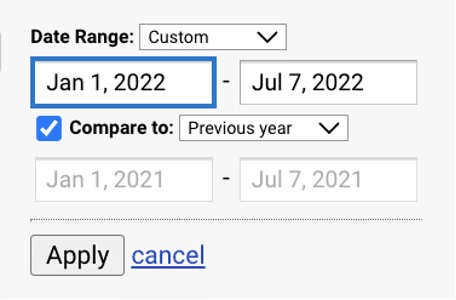

YOY traffic comparisons can be tricky to interpret these days given the world shake-ups that have happened in relation to the Covid-19 pandemic. Many sites we monitor saw huge drops in traffic in March of 2020 related to the official pandemic announcement and widespread lockdowns.
Here is one:

While this drop looks similar to an algorithm update hit, a lot of things changed in the world following March 11, 2020. This was the date on which the pandemic became a reality to most — the NBA shut down due to Covid fears and the US stopped allowing incoming air traffic. In essence, it created a real domino effect.
If your site has been operational for several years, you may find you need to compare this year’s traffic to pre-pandemic years to determine whether the changes you are seeing are simply normal seasonal fluctuations.
If business (i.e. sales, traffic, etc) has changed dramatically because of the effects of the pandemic, it may not be possible to thoroughly analyze the effect of the changes in user behaviour unless you are intimately familiar with which aspects of the business have been affected.
Jason Dodge had a good question when it comes to this topic:
How do you take into account outside environmental and economic factors that can impact your website traffic?
— Jason Dodge (@dodgejd) July 7, 2022
Sometimes it can be hard to know whether a world event or seasonal change has affected a site’s traffic. It obviously helps to know the industry that the site covers. A sports site is going to see fluctuations depending on what season each sport is in.
A tip for analyzing YOY traffic in GSC:
GSC’s interface makes comparing specific date periods difficult in some cases. We have found the Easy Custom Comparison Chrome extension very helpful here.
Analyzing trends:
Another helpful tip is to use Google Trends to see whether there has been a spike or decline in interest in the topics of the pages that are seeing traffic drops. Here is a client that came to us convinced they were affected by a Google update. We were able to discern in our traffic drop assessment that the specific decline they saw was likely explained by less interest in their topics.
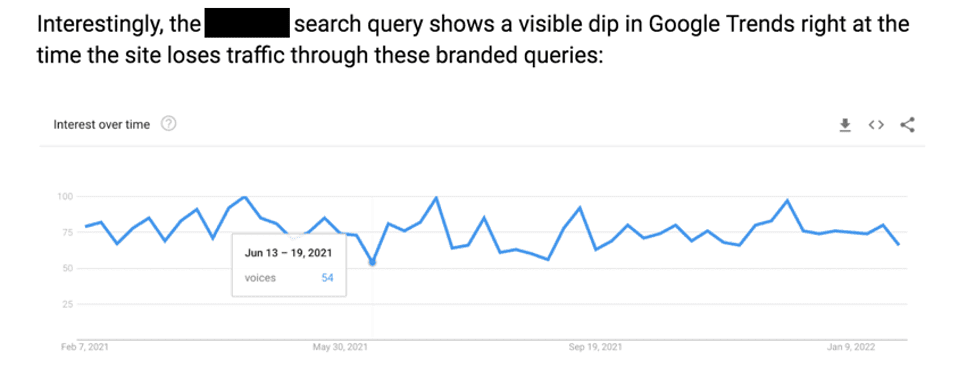
Here is another situation for a client that sees seasonal fluctuations. Their main product is in demand more often in the summer months. Traffic mirrored the Google Trends data.

Wherever possible we add significant world events or dates to our list of known and suspected algorithm updates.

It’s sometimes helpful to search for “top news stories from [date]” or “what happened in on [date]” to see if something dramatic happened in the world or locally at the time of your traffic drop as well.
In cases where world events have affected traffic, you should notice that traffic is down across all search engines and not just Google. With that said, however, in Google’s guide to how they fight disinformation they tell us that in “times of crisis” they may adjust their algorithms to prefer authoritativeness and trustworthiness. We believe this could contribute to traffic drops for many of the sites that saw changes in March of 2020 (early in the Coronavirus pandemic) and February 24, 2022 (Russia invaded Ukraine).
One final thing to consider when it comes to world events affecting site traffic is that much of the world is suffering from financial struggles right now. It may be that there is less demand for your products or services because we are in an unprecedented time of financial struggle.
Ah that's something i will add as well…I think some traffic drops could be due to the impact of the looming (or perhaps already here) recession😥
— Marie Haynes (@Marie_Haynes) July 8, 2022
SERP changes
Gone are the days of “10 blue organic links” on Google’s search results. Your traffic drop may be because Google has changed the search results to include (or not include) things like:
- featured snippets
- shopping carousels
- maps listings
- top stories
- interesting finds
- things to know
- image carousels
- people also ask results (as we were writing this article there was a massive decrease in the number of SERPs containing PAA’s)
Many sites that saw declines with the May 2022 Google core update lost all of their featured snippet rankings, but other rankings did not decline. Losing a featured snippet ranking can be devastating when it comes to inbound traffic.
These can be hard to measure if you are not already tracking your position in Google’s SERP features. GSC does tell us about some SERP features such as FAQ’s but most, including featured snippets are not reported on.
If you are a paid user of Ahrefs or Semrush, you can find historical information on your ranking in featured snippets and other SERP features.
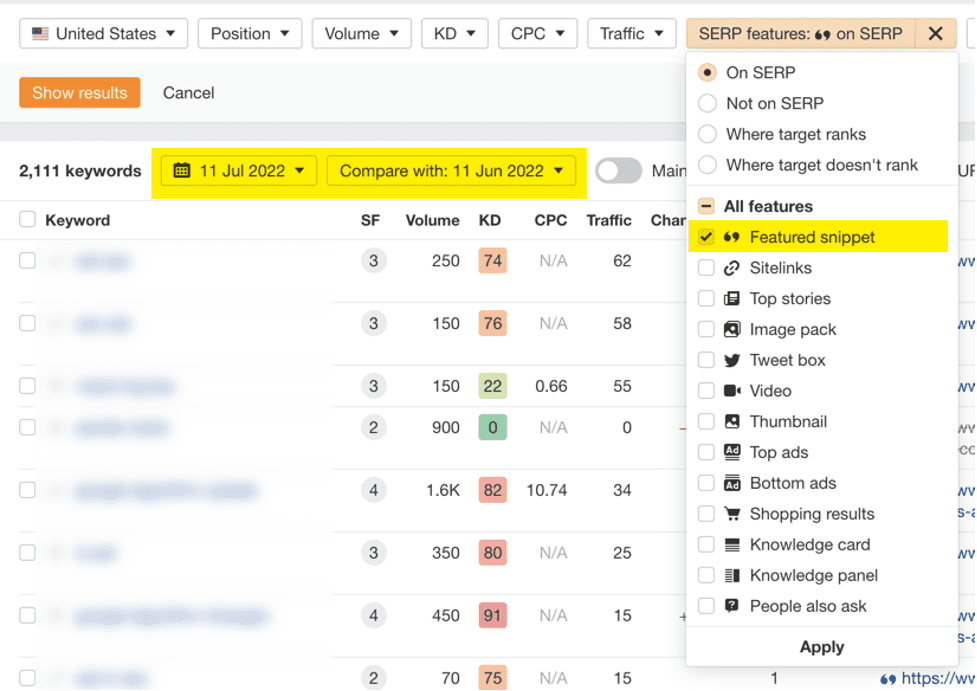
Screenshot from Ahrefs.com
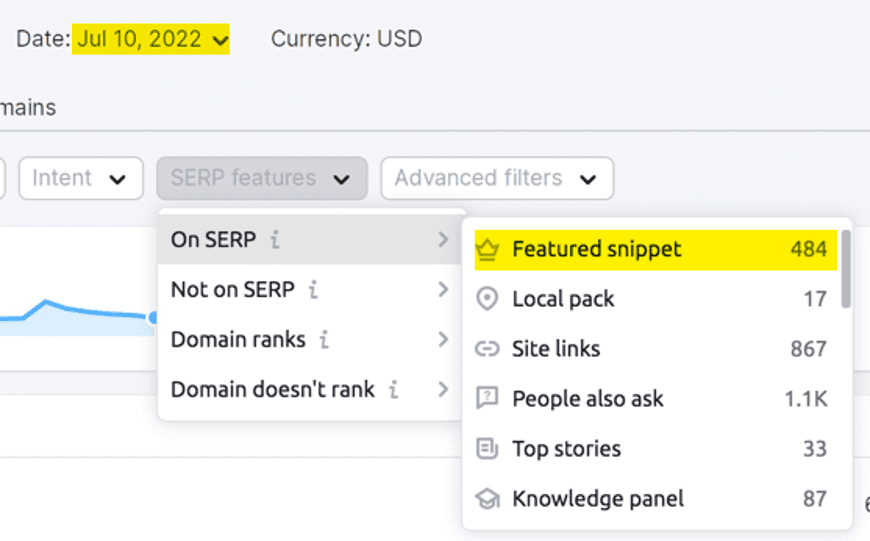
Screenshot from Semrush.com
Another excellent tool to help you keep track of changing SERP features is Mobile Moxie’s SERPerator created by Cindy Krum.
A Google penalty (manual or algorithmic)
Google penalties used to be a relatively common cause for a traffic drop. While Google does still dole out manual actions for sites that break their guidelines, it does not happen often now. We have found that most sites that come to us thinking they’ve been penalized by Google have not.
How do I know if Google has manually penalized my site?
If you have received a manual action from Google, you can find this in Google Search Console:
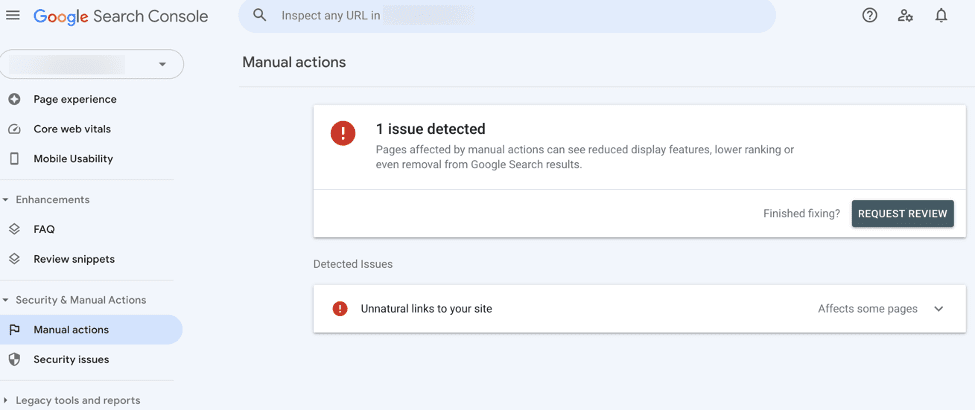
If you do not have a message in GSC, then there is no manual action on your site. Sites with a manual action will be given details of which guidelines they have broken such as unnatural links pointing to your site or pure spam. You can then clean up the issues and request reconsideration. A webspam team member will review your reconsideration request and if successful, the manual action will be lifted.
If a drop feels like a manual action, but none is present, this leads us to our next commonly asked question…
Is it possible Google has algorithmically penalized my site if there is no manual action shown in GSC?
While algorithmic suppressions are possible, they are much less common than they used to be. In the early days of Google’s Penguin algorithm, we would commonly see sites that were clearly suppressed by Google’s algorithms because of aggressive unnatural link-building tactics. Back then, we could use Google’s disavow tool and see some measure of recovery the next time Google ran a Penguin update.
While Penguin is still in the algorithm today, in 2016 this algorithm changed to ignore unnatural links rather than penalize maintaining them and to run in real-time. Google has hinted that it is still possible for a site to be algorithmically suppressed because of unnatural link building, but only when the scale of the problem is massive and their algorithms have a hard time determining which links to count and which to ignore.
We have written extensively in the past about our advice for assessing link quality and using Google’s disavow tool.
While we still do some disavow work at MHC, we have found that unnatural links are not commonly the suspected cause for a site’s drop in traffic in 2022.
If you have a history of building a large number of links that could go against Google’s guidelines you may be interested in having an MHC site auditor review the links pointing to your site. We can give you our thoughts on whether a disavow is likely to help.
Competitors have improved
Losing a top ranking position for a popular keyword can have a dramatic impact on traffic. Your loss may not be because you have done something wrong. It may be that a competitor has improved their content or has received more authoritative links.
It is common to see competitors overtake your rankings following a Google update, but this can also happen with day-to-day regular ranking changes.
If you are seeing losses in traffic for particular keywords or pages, we recommend reviewing the search results to look at which pages have been promoted above yours.
You can use a tool like Ahrefs to see whether this page has obtained new links. We believe that Google’s algorithms still use PageRank (link authority) as an important ranking factor, but there is likely much more to Google’s ranking system today. Google’s Hummingbird algorithm opened the door for them to put more emphasis on semantic search capabilities (i.e. understanding the language in a query and also on a page) and possibly less on PageRank. Still, if a competing page has been the beneficiary of new authoritative links this can certainly cause it to outrank you.
For more on how Google’s algorithms are likely changing to better understand user intent and likely page content/quality as well:
- What is semantic search? – Marie’s podcast episode on YouTube
- Using knowledge of semantic search to improve E-A-T
- Semantic SEO & E-A-T: An in-depth discussion with Marie Haynes & Olaf Kopp
In some cases, looking at competitors’ new links can help you generate similar ones. Has a reporter written about your topic? You can create a relationship with that reporter and offer your client as a reputable source should they ever cover more on this topic. Has the page been added to a good list of resources on a topic? If you have a really good resource you may be able to get yours in there too. We have found, however, that techniques that require outreach to ask for a link have a low success rate now as most site owners are continually bombarded with requests for links. By far the best plan of action here is to create content that is dramatically better and more helpful than your competitors. Content that people want to share and link to without being pestered to do so, is usually really good content.
It can also be helpful to monitor whether your competitors’ pages have changed preceding a ranking improvement. Look at the page on archive.org and use a tool like Diffchecker to determine which content has changed. Do these changes make the page more helpful for searchers? Could you make changes to make your pages even better and more helpful?
How can algorithms determine if the content on a page is more helpful?
We believe that Google is using machine learning to determine the weights of many ranking factors in an effort to elevate pages that do a good job of helping searchers find an accurate answer as quickly as possible. Google says they do this in their documentation on How Google Search Works.

This means that the reasons for a page to outrank you go beyond a list of easily measurable SEO factors. For many queries, Google is likely using machine learning to determine which pages are the most relevant and helpful. As such, it may be helpful to ask others to compare your page to competitors and share why they feel one page is more or less valuable. You can also run surveys or use a tool like five-second test to ask questions of real people regarding the value of your content.
If nothing has changed on your competitors’ page and no new links have been obtained, it may be that Google has changed their understanding of a searcher’s query and their intent. This usually happens during a Google update (either announced or unannounced). For example, if you have an informational page that is now being outranked by an eCommerce store, it might be that Google has determined that most people who search for this query want to see transactional results.
In some cases, Google’s algorithms may determine that user intent has changed so that content that is concise is preferred over long-form content. What we as SEOs feel is “good content” may not always be the best to meet the searcher’s needs. You may find this Cyrus Shepard article on the Moz blog interesting as it discusses Google patents that look at using user engagement signals to train machine learning models.
Cyrus explains how Google has a patent describing that the amount of time users spend engaging with a page could be considered a sign of quality.
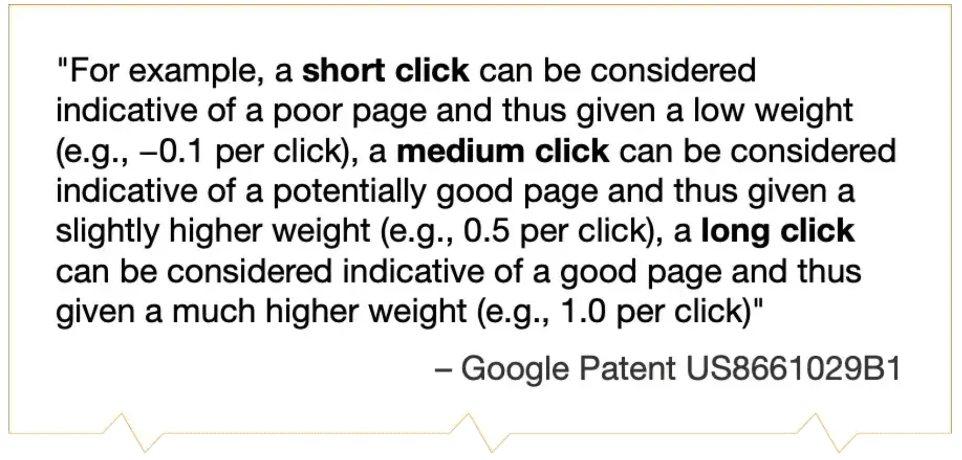
But in some situations, the algorithm may recognize that a short click actually is more indicative of a page that met the searcher’s needs.
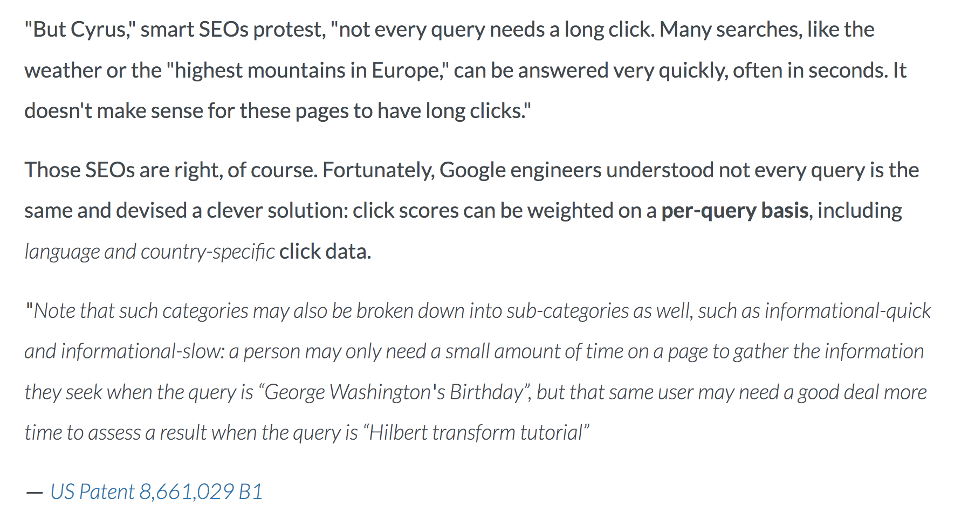
There are things that can be done to improve following a shift in Google’s understanding of intent or relevancy, but in a lot of cases, a loss like this is hard to remedy. We will have much more on assessing and remedying intent and relevancy shifts in part two of this series in assessing a drop in traffic.
Adult content
Google does not want to accidentally show adult content to searchers unless they very specifically want it. And in some cases, even when people are clearly searching for explicit content Google will err on the side of caution. Here is a case we wrote about where an adult toy shop stopped ranking for its brand name. While we never resolved the issue, the general consensus was that their brand name was similar to a children’s nursery rhyme. It does not even rank with SafeSearch turned off. Google does not want to risk accidentally sending children to sites with adult content.
If your content contains some adult text, images or video, you can try seeing if searches are different with SafeSearch on vs. off. If you rank with SafeSearch off, but not with it on, then adult content could be impacting Google’s assessment of quality or trust for your site.
Another thing you can try is to experiment with site commands (here’s a comprehensive list from SEJ) to see if perhaps your content has been hacked and injected with adult content. For example:
site:yoursite.com [viagra]
site:yoursite.com [sex]
You should not be filtered by SafeSearch for simply having those words. (If that was the case, this post you are reading now would not rank!) What you are looking for here is evidence of clearly NSFW content that is not meant to be there.
If your site purposely has a mixture of adult and non-adult content it can possibly be helpful to isolate the explicit content in its own folder or subdomain. John Mueller mentions this advice in a Google help hangout. This can make it easier for Google to trust the non-adult sections of your site.
A problem on Google's side (rare)
In over ten years of consulting on Google organic ranking issues, I have occasionally come across a case where I felt something was seriously wrong on Google’s side. Please know though that this is very uncommon.
- The webspam team made a mistake and forgot to remove a penalty
- Google reapplied a penalty and gave us no notice
Both of the above cases happened in 2014. Since then I can recall four additional cases where we reached out to our contacts at Google to ask for help because we felt that something was wrong on their side. For each case, we did a thorough site quality review and found no technical issues or serious site/content quality issues and also felt that the sites truly did not deserve the massive reduction in rankings they saw. We then wrote a post in the Google help forums describing the issue and were able to get the posts in front of a Google employee. In three of these cases the problem “magically” resolved itself shortly after our post, without any further work on our side. The fourth is the case mentioned earlier of the adult website whose name was similar to a children’s nursery rhyme. This one did not resolve.
In every other case when a site has contacted us thinking that a problem on Google’s side is keeping them from ranking, we could find issues with E-A-T or content quality, shifts in Google’s understanding of user intent, or in a few cases technical reasons for the site’s massive decline. Most likely if you have suffered ranking or traffic drops the problem is something else that we have mentioned in this article and not because Google has messed up. Still, if you are interested in having us investigate your case you can reach out here.
A new site that was doing well but is now struggling to rank
It is not uncommon to see this happen. Sometimes Google appears to give a site what we call a “honeymoon boost”. When this happens the site can rank well for some time and then eventually drop in rankings across the board. We see this often for sites that have a sudden, rapid influx of inbound links that were made for SEO purposes. These links can sometimes help improve rankings dramatically until eventually Google figures out that they are not legitimate mentions that should count as recommendations.
Here is an example. Ahrefs shows that this site created for affiliate sales had a big increase in referring domains since launching recently. This site was building its own links for SEO purposes.
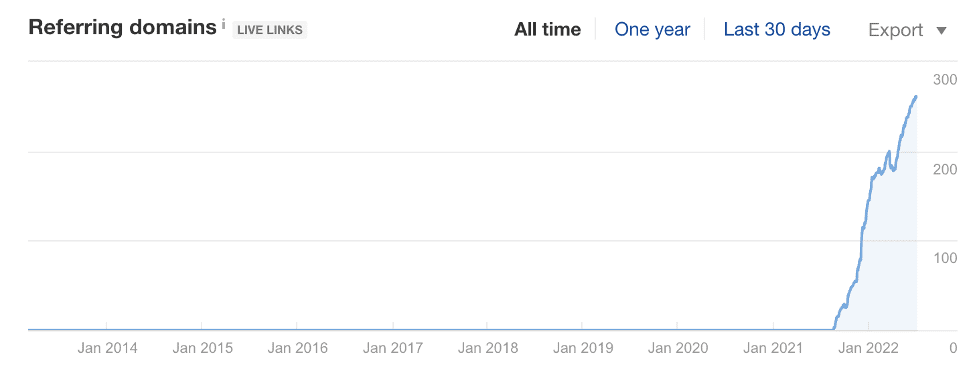
Organic traffic and keywords skyrocketed and then very quickly fell to zero.
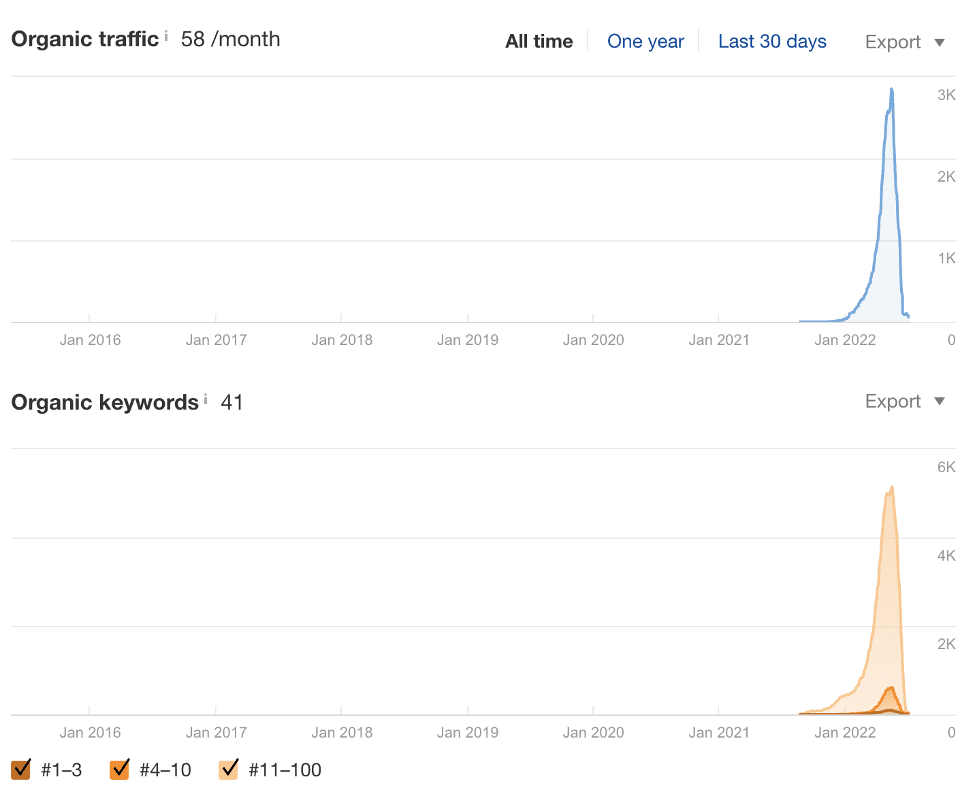
This is not a problem that can be easily remedied. We do not recommend building links simply for SEO purposes. Links are likely still important in Google’s algorithms, but only those that truly represent people wanting to recommend your content. There are still some SEOs who can find ways to trick Google’s algorithms into thinking that their link profile is authoritative when it is not. But it is getting harder and harder to do this.
Loss of links
PageRank is still an important part of Google’s algorithms. In some cases, if you have lost a significant number of important links pointing to your site, it could cause you to lose ranking positions.
In most cases, losing a single link is unlikely to cause significant ranking changes. It’s worth mentioning though, especially if you are diagnosing the reason for a drop in one particular URL. Again, a tool like Ahrefs can help you determine if a particular page has lost important links.
Links that are important enough to drive significant rankings likely also sent traffic. You may be able to find clues by looking at referrals in Google analytics to see if any of your top referring links have stopped sending traffic your way.
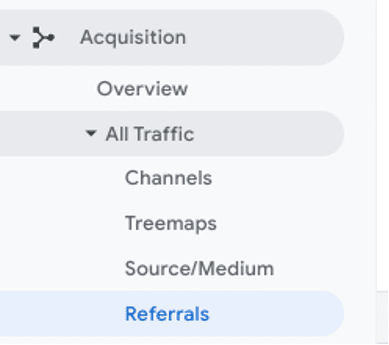
Reporting issue
If traffic has dropped to zero, there’s a strong possibility that something has happened with your Google Analytics script. Here’s an embarrassing situation where I thought I was hit by Panda many years ago, but in reality, I had relaunched my site and forgot to include my Google Analytics tracking code.
Confession. For years I have talked about this "client" who launched a redesign coincidental with Panda 4.0 to show that not all drops are related to updates.
The client was me. It was my site. pic.twitter.com/dxXdYQr9Xr
— Marie Haynes (@Marie_Haynes) November 17, 2021
We have seen similar things happen for past clients who have moved to GA4 from Universal Analytics. When you migrate to GA4, we recommend keeping your GA3 tracking codes on your site until Google fully sunsets Universal Analytics.

How to assess a slow ongoing decline
This is something we commonly see:
how to diagnose the multi-year site wide slow decline with no obvious cause
— Greg Bernhardt 🐍🌊 (@GregBernhardt4) July 7, 2022
Where to start with a site that has slow steady decline over a 2 year period with no discernable reason.
— Leanne Summers (@LeanneSEOwriter) July 7, 2022
In most of these cases, you will not find a smoking gun or an obvious problem to blame for the erosion of traffic. If the decline starts on one particular date, you can check this date across our algorithm update checklist to see if we have identified a particular change in Google’s algorithms.
A common date on which many sites started to see slow, ongoing declines in traffic was November 8, 2019. Google did not announce an update on this day, but it is interesting to note that it followed closely after Google’s announcement about using BERT to better understand searches. We can’t prove this, but we feel that at this time Google’s algorithms have more semantic search capabilities now (i.e. understanding language in queries and possibly also on pages). While PageRank is still important, the move towards being a more semantic search engine means that Google’s understanding of intent and relevancy has likely changed. The more their machine learning algorithms learn about what is relevant, the less effective SEO tactics like link building for the sake of PageRank may become. This will be discussed in part two of this series.
Additional tips from the SEO Twitter community
I asked on Twitter what questions people tend to address when diagnosing traffic drops and got some incredible replies. It’s amazing how the SEO community is so willing to help each other!
How long has it been since you last updated the content with value information?
— Dileep Thekkethil (@dileepp89) July 7, 2022
Has it been caused by position drops or other SERP or market factors? Fewer searches in market, product interest decline, has PPC strategy changed, new SERP features like local/image packs or increased shopping visibility. Soooo many more things…
— Craig Gilhooly (@CraigGilhooly) July 7, 2022
– Compare YOY
– Check if things are technically OK
– Identify dropped terms
– Make sure it's unrelated to changes I made
– Look at SERPS
– Look at comparable websites
– Improve content on dropped pages
– Make sure my pages are better than competitors
– Wait until Google fixes it— Tinus (@Tinusg) July 7, 2022
* Specific page(s), section(s), or across the site?
* Specific term(s), most terms, or all terms?
* Was it already in decline?
* Was there a recent core update?
* Has/have the page(s) rankings changed?
* Have other pages switched pos. in the SERP?
* Have the SERP changed?>>>
— Darth Autocrat (Lyndon NA) (@darth_na) July 7, 2022
>>>
* Has someone added a "plugin"?
* Has someone altered a "theme"?
* Has a plugin/theme been updated?
* Does the site show for operators (site:/inurl:)?
* Do the impacted URLs show for quoted queries?
* Do the impacted URLs show for allintitle:?>>>
— Darth Autocrat (Lyndon NA) (@darth_na) July 7, 2022
6) You or someone else has filed a successful URL removal request on your site.
Solution: You'll have to cancel or dispute the request to appear in the search again. Further, this article might help → https://t.co/ww0LtLUDrO
— Rahul Marthak (@RahulMarthak) May 10, 2022
*Did Google change the SERPs recently
*new featured snippet started appearing,
*top stories started appearing,
*PAA showing on top,
*keyword ranking dropped,
*searches for topic dropped (trends), Impressions (GSC)
*changes in content
*UI changes
*Tech changes
*links changes— Ramesh Singh (@ramesh_s_bisht) July 7, 2022
my main question and I guess you cover this above is did the page *deserve* the drop and if traffic existed before how can the now demoted content be better framed,
— Mike (@Fearless_Shultz) July 7, 2022
Events? shootings? Increased covid illness? Holiday? Specific state/city occurrences?
Seasonality? Vacations? Industry-wide issues? Tool problems? Site section specific issue? Changes to website? Look at competitors & position tracking. Lots to consider to fit one tweet 🙂
— Melissa Fach 🇺🇦 (@SEOAware) July 7, 2022
– how does it compare YoY and previous years
– is it trend/seasonal related
– when did the decline begin? Technical related? Algorithmic?
– what keywords declined the most for the specific pages/niches— Sunny Matharu 💬 (@s_matharu) July 7, 2022
Just as important to know is if the featured snippet was replaced. If it wasn't replaced then Google is learning from click analysis that featured snippets do not work for that query if it was replaced then the strategy for the query changes.
— Terry Van Horne (@terryvanhorne) July 7, 2022
It sounds counterintuitive to say that losing traffic is a positive thing but if you can look at a loss around say a news article or a forum post and accept that you never actually intended rank for it but there is demonstrable interest then yay free kw research
— Mike (@Fearless_Shultz) July 7, 2022
Has your site lost traffic?
If after reading this article you are still struggling to determine why your site has lost rankings or traffic you can reach out to me and my team for a site quality review or consultation. If your losses have been coincidental with a Google core update, stay tuned for part two of this series where we will dive into ways to diagnose and potentially remedy the losses seen.
I am always looking for sites to review when it comes to traffic drops. If you are interested in submitting your site for me to use for my research you can use one of the forms below or DM on Twitter @Marie_Haynes or @mhc_inc



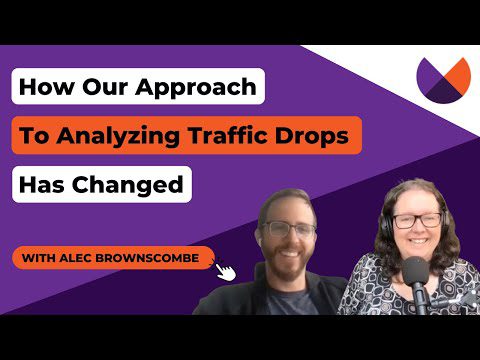


Comments are closed.